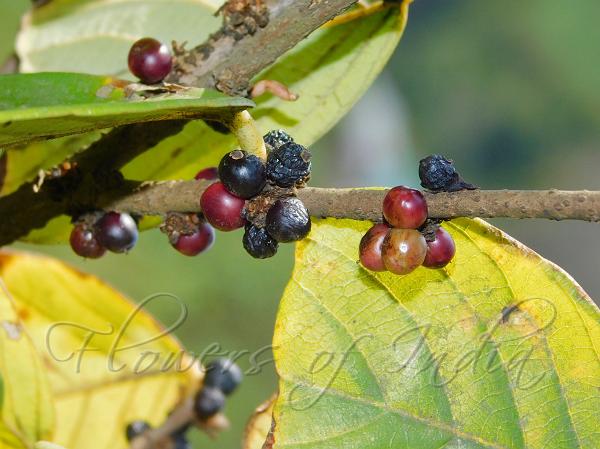|
| Warty Bridelia |
|

|

| File size | 841630 |
| Original date | 5/5/23 3:42 PM |
| Resolution | 4037 x 3024 |
| Flash | Flash fired |
| Focal length | 32.7mm |
| Exposure time | 1/320s |
| Aperture | 5.4 |
| Focus Distance | |
| Metering Mode | Multi-segment |
| Camera make | NIKON |
| Camera model | COOLPIX B500 |
| Sensor type |
|
|
|
|
Photo: |
Botanical name: Bridelia verrucosa Family: Phyllanthaceae (Amla family)
Warty Bridelia is a large shrub or small tree, about 3
m tall. Twigs hairless, warty on account of the prominent lenticels.
Leaf-stalks are 5 mm long. Leaf-blade elliptic-obovate or broadly
elliptic, 8-12 x 5-7.5 cm, blunt, rounded or notched at the tip,
wedge-shaped, rounded or sometimes slightly heart-shaped at the base,
entire, papery to thinly leathery, lateral nerves 8-15 pairs, scarcely
prominent above, prominent beneath, parallel, reaching the margin;
hairless above, sparingly velvet-hairy beneath. Flowers are arranged
only in fascicles, which are commonly unisexual, although sometimes
bisexual. Flowers are shortly stalked or stalkless. Male flowers have
stalks 1 mm long, hairless; sepals oblong-lanceshaped, 2 mm long,
pointed, hairless; petals spoon-shaped to fan-shaped, 1 mm long. Female
flowers are stalkless; sepals triangular-ovate, 1.5 mm long, petals
elliptic-oblong, 1 mm long; outer disc roundly pentagonal, inner disc
completely enveloping the ovary, only the styles protruding. Fruits are
ovoid, 5-6 mm long, 4 mm diameter when dried, black. Warty Bridelia is
found in the Himalayas, from Kashmir to NE India, at altitudes of
700-1200 m. Flowering: September.
Medicinal uses: Warty Bridelia is widely used
in traditional medicine. It is valued for its therapeutic abilities in
the treatment of fever, skin disorders, diarrhea, headache relief, and,
toothache treatment. Its various therapeutic uses highlight its
importance in traditional medical practices.
Warty Bridelia is widely used
in traditional medicine. It is valued for its therapeutic abilities in
the treatment of fever, skin disorders, diarrhea, headache relief, and,
toothache treatment. Its various therapeutic uses highlight its
importance in traditional medical practices.
Medicinal uses:
 Warty Bridelia is widely used
in traditional medicine. It is valued for its therapeutic abilities in
the treatment of fever, skin disorders, diarrhea, headache relief, and,
toothache treatment. Its various therapeutic uses highlight its
importance in traditional medical practices.
Warty Bridelia is widely used
in traditional medicine. It is valued for its therapeutic abilities in
the treatment of fever, skin disorders, diarrhea, headache relief, and,
toothache treatment. Its various therapeutic uses highlight its
importance in traditional medical practices. | Identification credit: Nishant Chauhan | Photographed in Hamirpur, Himachal Pradesh. |
• Is this flower misidentified? If yes,